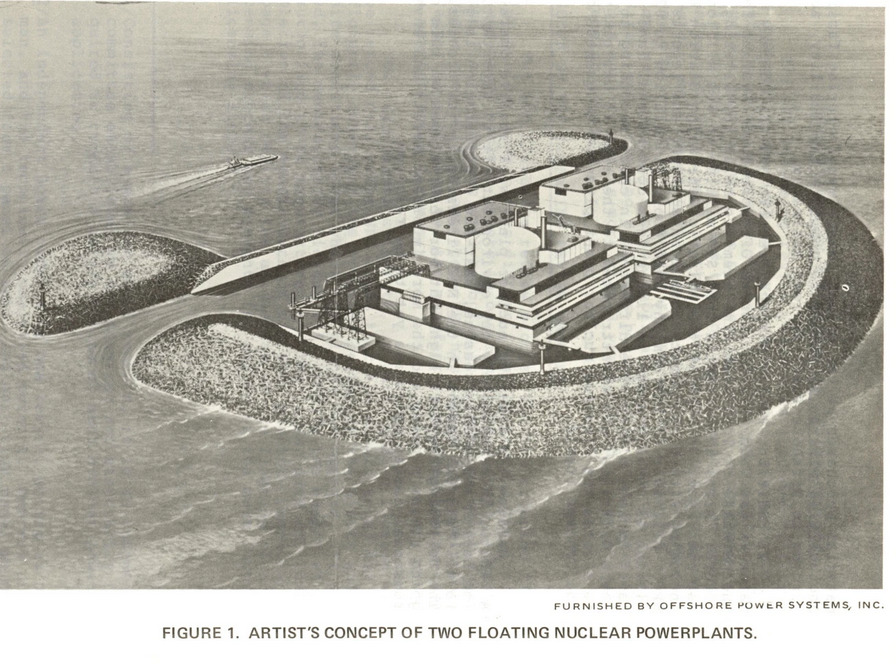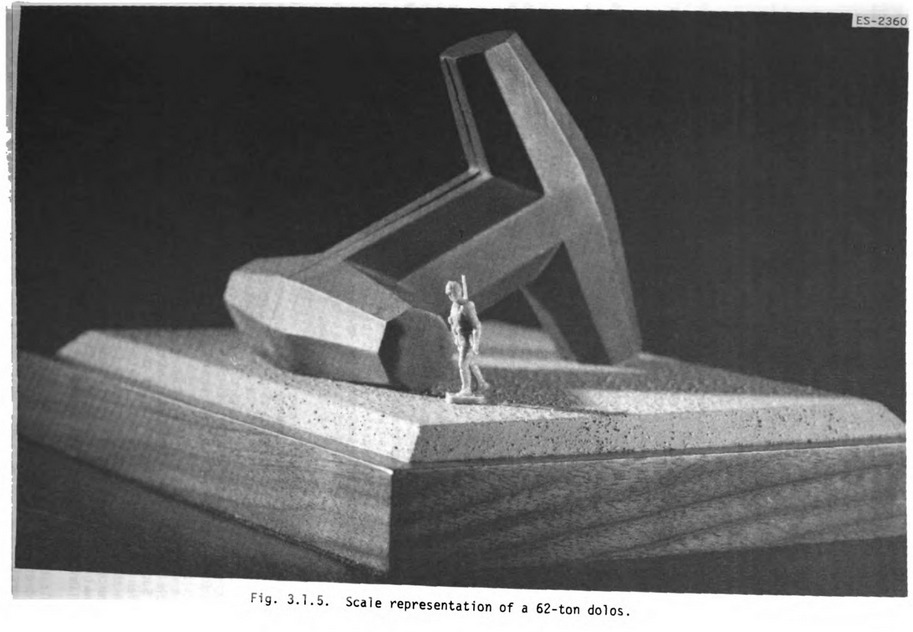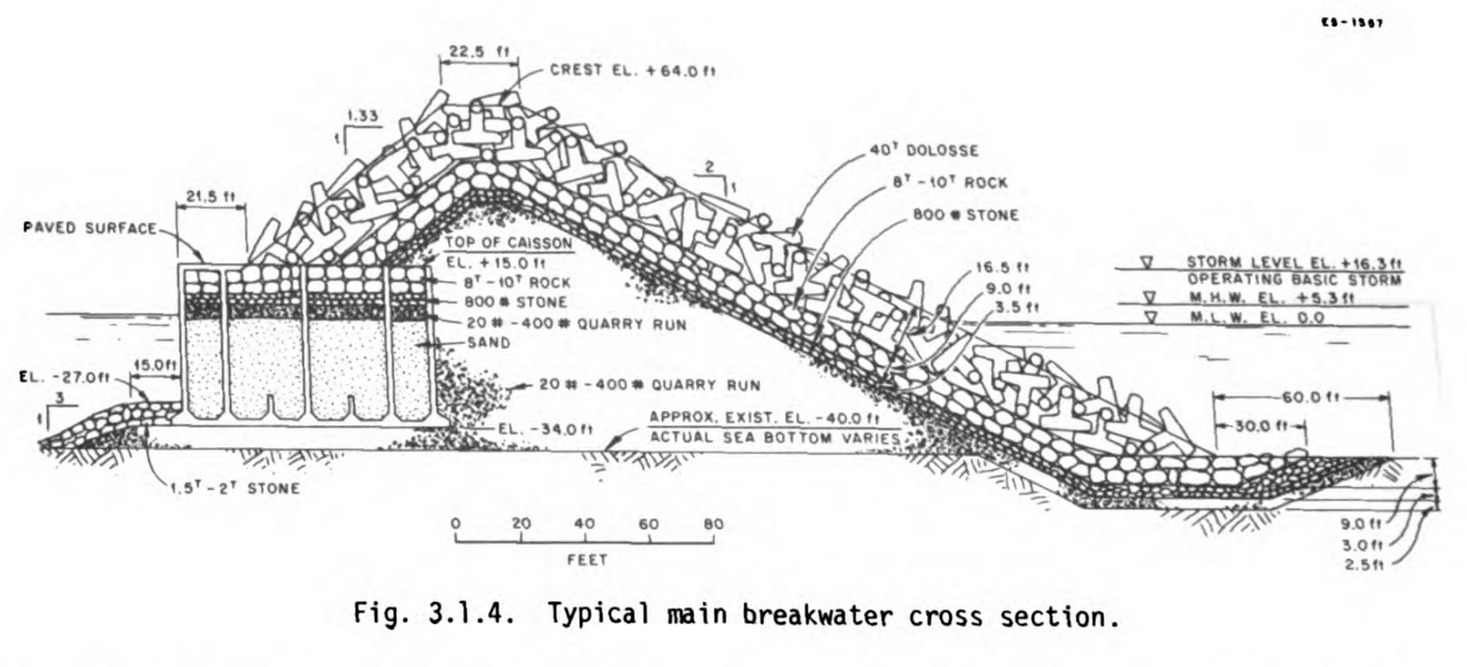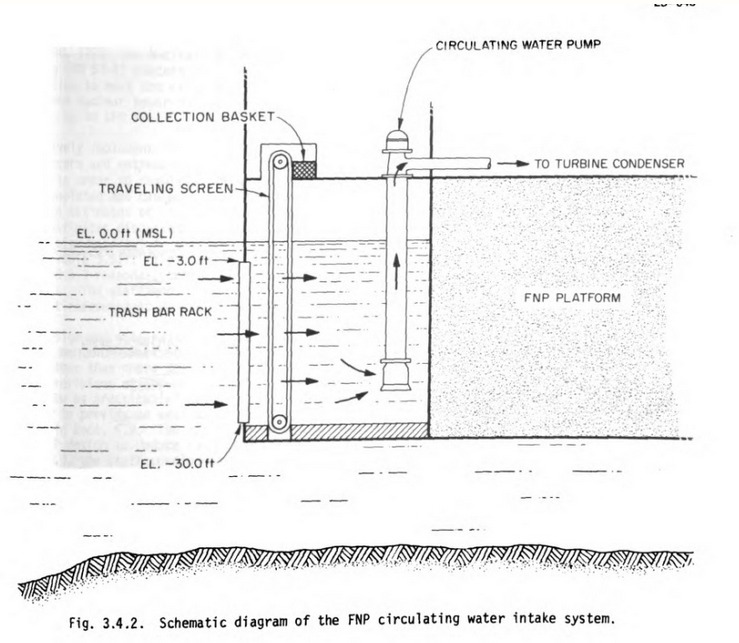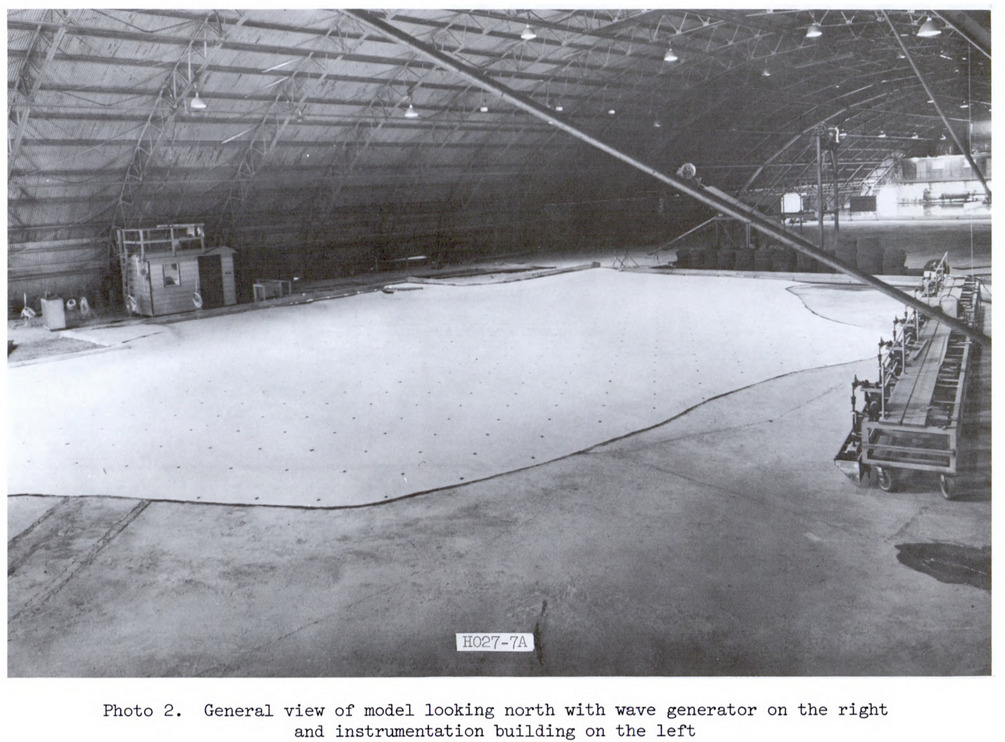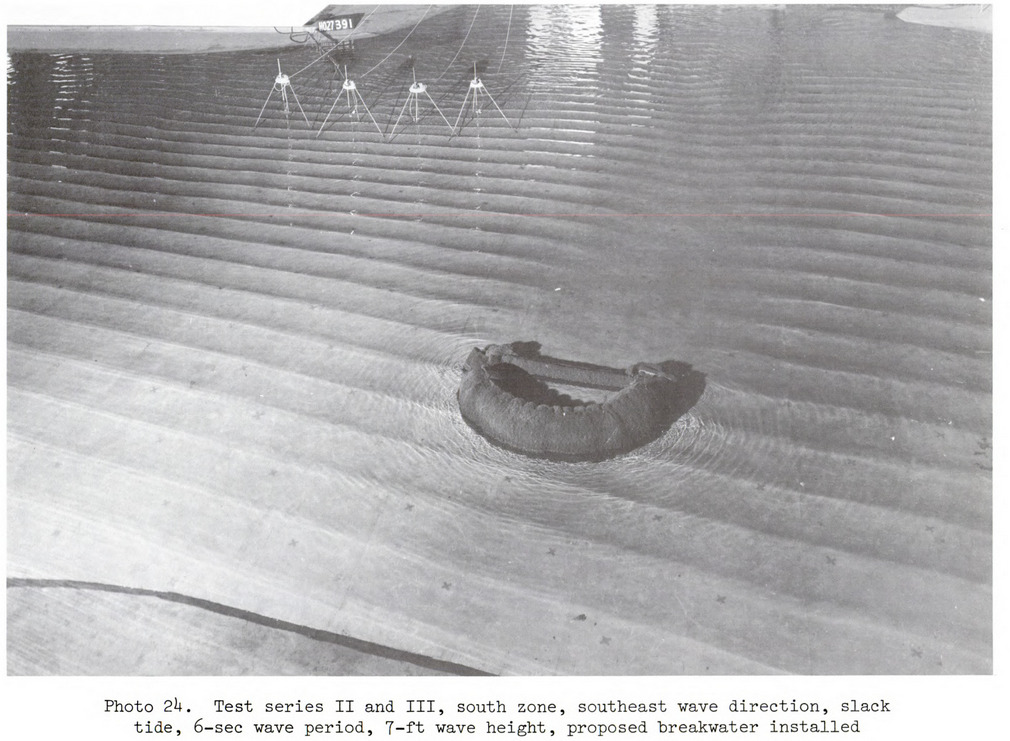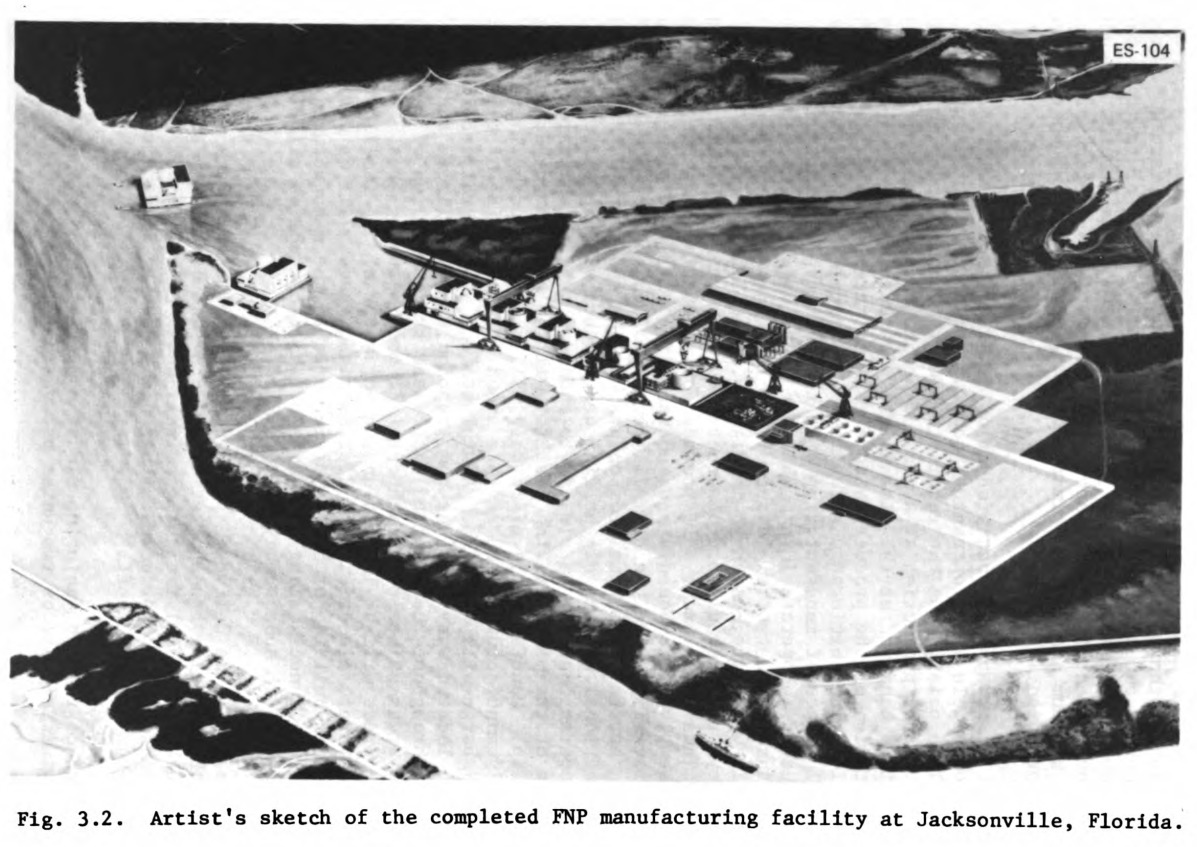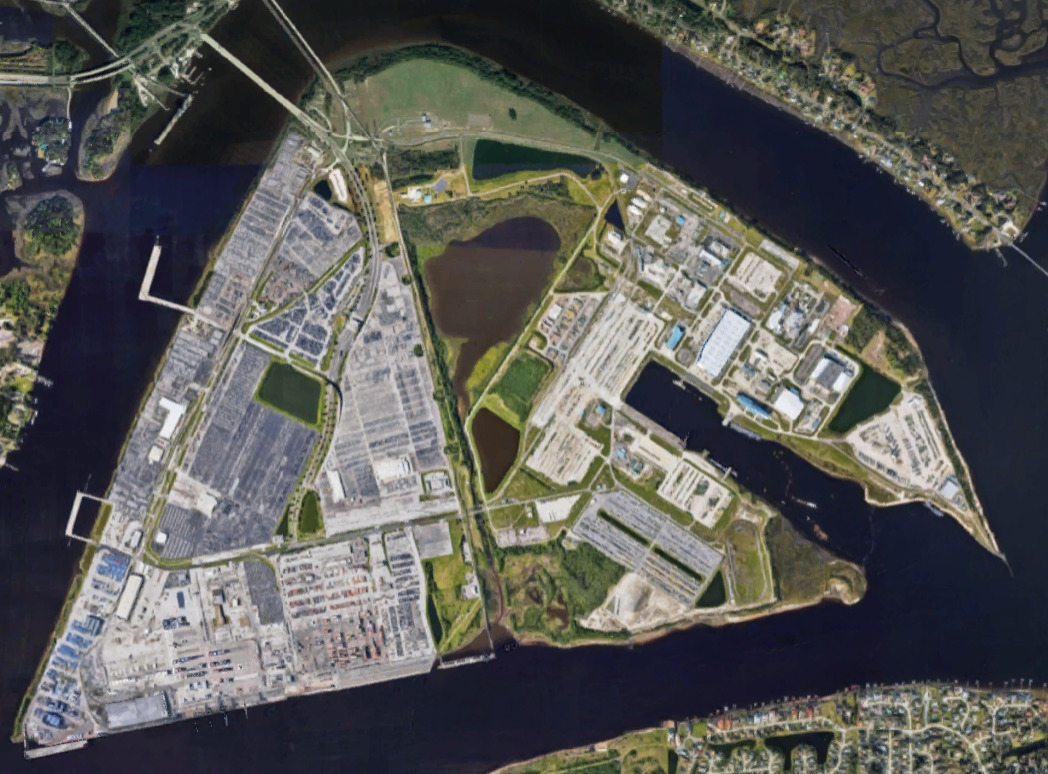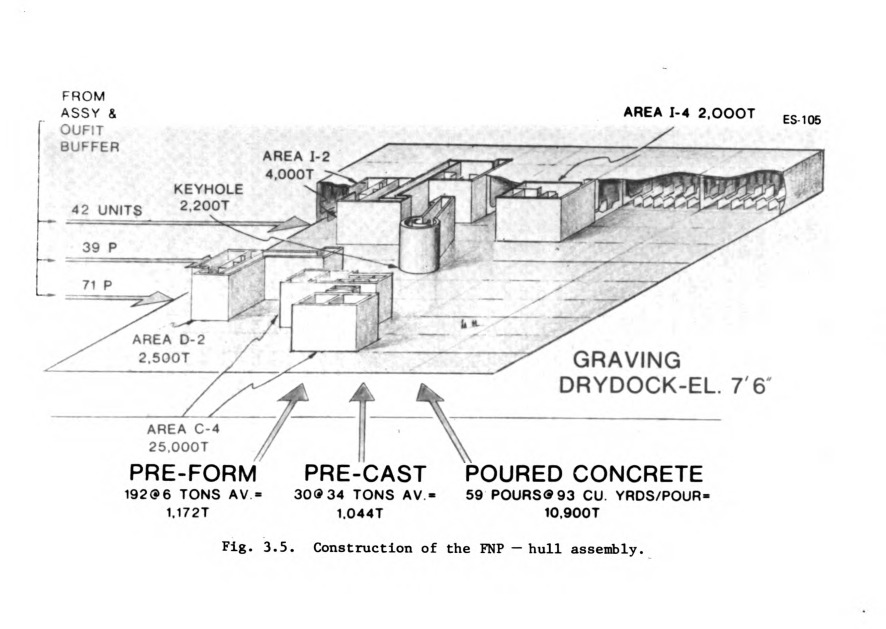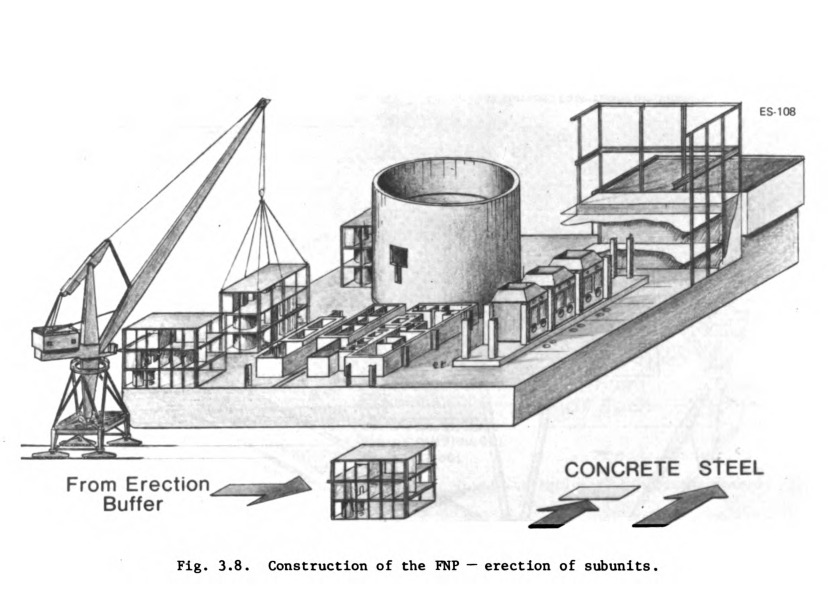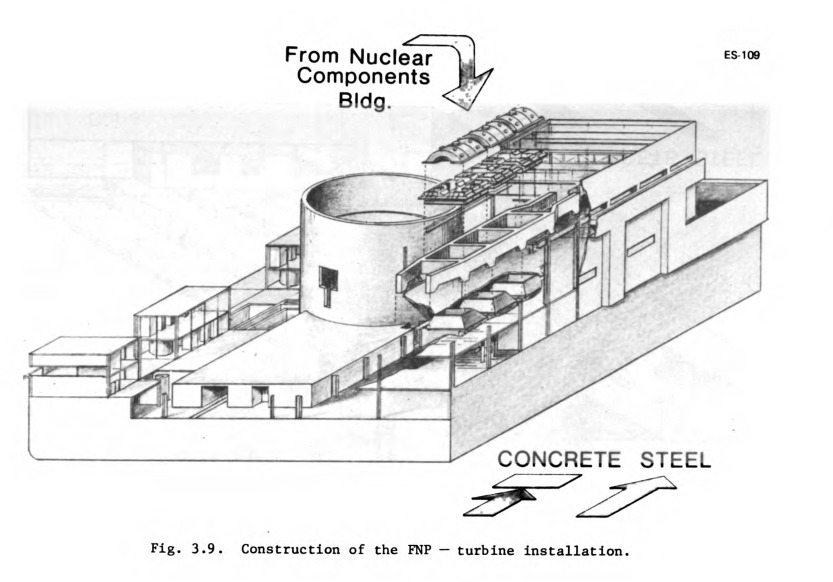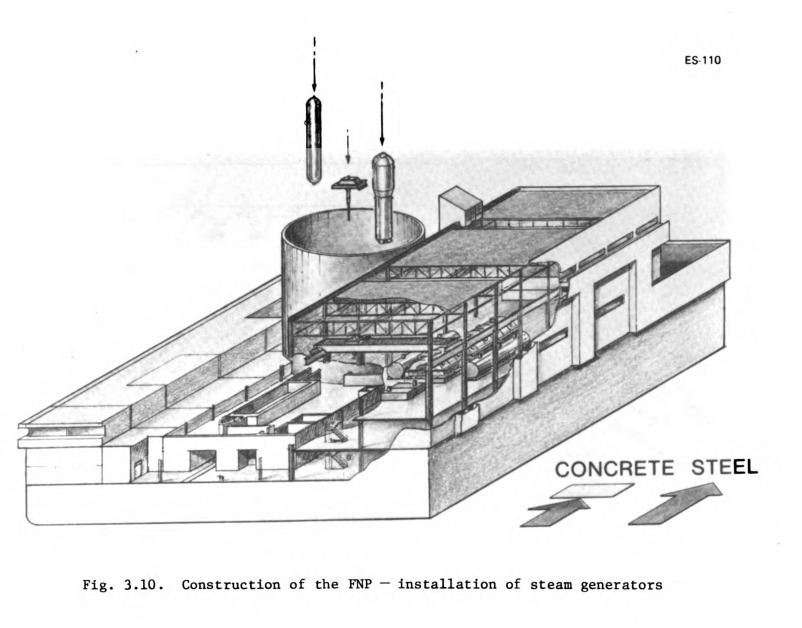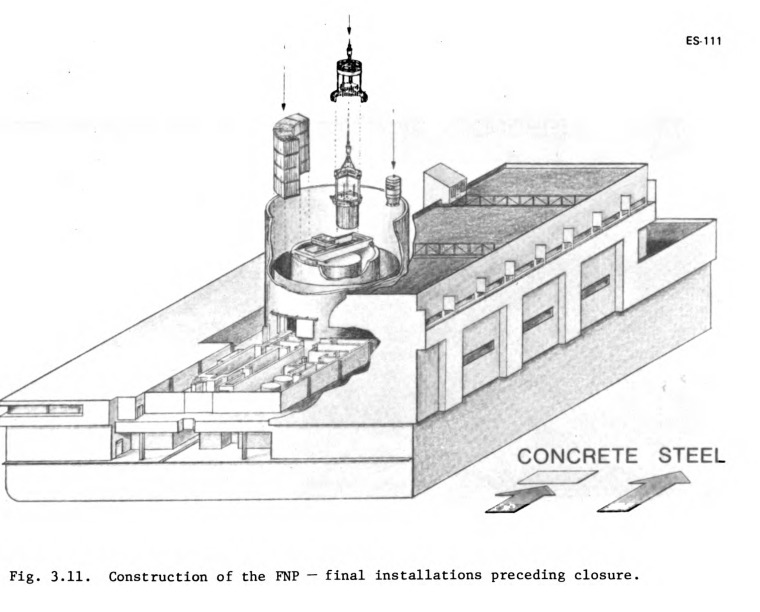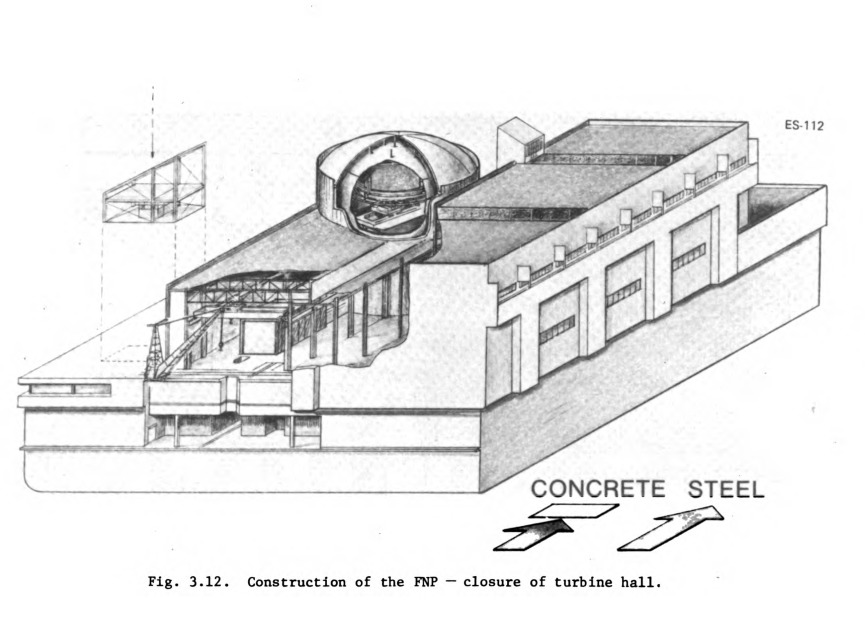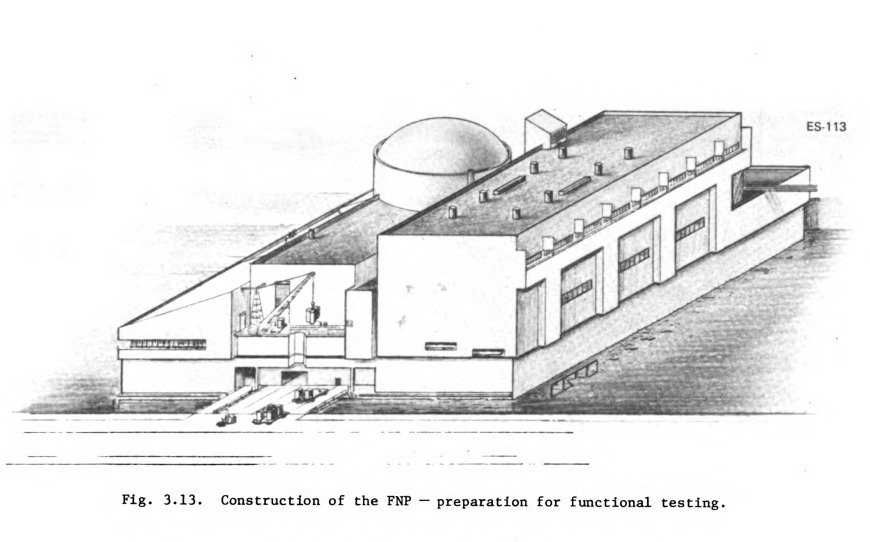Offshore nuclear power plants
That time we almost built 8 GW-scale floating reactors
By Nick Touran, Ph.D., P.E., 2020-01-26 , Updated 2020-12-29 , Reading time: 19 minutes
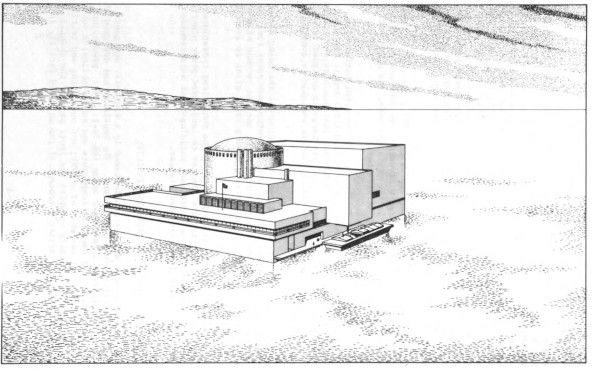 In 1969, at the height of the First Nuclear Era, an engineer at New Jersey’s PSE&G utility
company named Richard Eckert imagined a peculiar model for manufacturing, siting, and
delivering nuclear power plants3. New Jersey was anticipating brownouts soon and had to
expand capacity, but suitable sites were all taken. What if, he wondered, huge nuclear
plants could be built in serial at a production facility, put on a barge, and floated
to sites out at sea?
In 1969, at the height of the First Nuclear Era, an engineer at New Jersey’s PSE&G utility
company named Richard Eckert imagined a peculiar model for manufacturing, siting, and
delivering nuclear power plants3. New Jersey was anticipating brownouts soon and had to
expand capacity, but suitable sites were all taken. What if, he wondered, huge nuclear
plants could be built in serial at a production facility, put on a barge, and floated
to sites out at sea?
I had heard of Offshore Power Systems and their power plant assembly line before, but until recently I did not understand how far along they really had gotten.
The idea of Floating Nuclear Power Plants (FNPPs) always sounds a little crazy at first, as it did to Eckert’s wife when he told her of his idea. But given some thought, many enticing characteristics are revealed. After all, the first power reactors were made to propel naval submarines, hundreds of which have prowled the seas since 1955. A civilian nuclear-powered merchant ship (NS Savannah) had been built and operated. The US Army’s MH-1A Sturgis nuclear plant on a barge had helped power the Panama Canal for years.
The proposed Atlantic Generating Station
PSE&G went to work on the idea quickly. They named their first FNPP site the Atlantic Generating Station, located 2.8 miles off the New Jersey coast. Design work and environmental studies commenced rapidly.
PSE&G was gambling enough on siting, they wanted to use a tried-and-true reactor design. They promised to be a customer for Westinghouse PWRs if they could be built on floating platforms. Westinghouse knew plants, but needed help on the floating side. Thus, Offshore Power Systems (OPS) was formed on July 6, 1972 as a 50/50 joint venture between Tenneco Power Systems (who owned the Newport News shipyard) and Westinghouse Electric Corporation. It proposed to design, manufacture, and market complete nuclear power plants of a standardized design and integrated with specially designed floating platforms 5.
Each floating nuclear power station (FNPS) would contain two or more FNPPs within a protective breakwater. The individual plants were to be 1150 MWe Westinghouse four-loop PWRs with ice-condenser containments. They had once-through steam condenser cooling with no cooling towers. Electricity was to be transmitted at high-voltage (345 kV) through submerged cables beneath the sea bottom. A shore support facility would provide a staging area, a docking facility, office buildings, and parking.
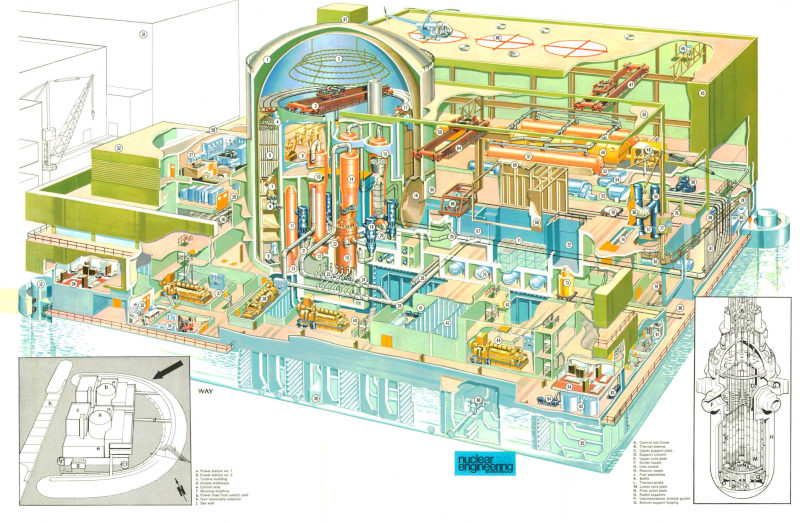
A detailed diagram of the Atlantic Generating Station (from Nuclear Engineering International)
In lieu of massive concrete foundations, the bulk of the concrete would be in the breakwater, which required 17,000 concrete dolosse (which resemble child’s jacks), with each dolos weighing between 11 and 62 tons, interlocked into an armor surface to protect from storm-generated waves and to prevent ships from colliding with the FNPPs. The cassion sand fill was expected to be sourced from the sea bottom.
The AEC informed OPS of the pre-application review on October 20, 1972, which concluded that1:
The integration of land-based nuclear power plant technology to the platform-mounted nuclear plant concept does not appear to present major problems, based on the information presented to day, and that it appears to be a feasible concept.
Environmental studies
Vast environmental studies, hearings, and licensing activities were required. The environmentalist movement was in full-swing at this point, and so the impact of the proposed plants on every fish and critter from the Maine coast to the Texas coast was studied.3:
Hydrologists were brought in to make thermal studies to establish isotherms for varying tide and current conditions. Because cables would someday have to come out of the water and traverse land in order to bring power from the ocean to the people, general ecologists were commissioned to begin field studies that would eventually consider every tree, every bird, every animal — literally, every mouse— that might in any way be disturbed: white footed mouse, meadow jumping mouse, house mouse, pine vole, Norway rat, short-tailed shrew, least shrew, semi-palmated sandpiper, American widgeon, horned grebe, Atlantic white cedar, pitch pine, rabbit-foot clover, many hundreds of other species.
PSE&G contracted Ichthyological Associates, who ended up specifying many design characteristics of the plant in accordance with their research. The warm water and large breakwater would attract much life, and the plant had to be designed to minimize harm.
There would be more fish and shellfish in that area than in any other square mile in the Atlantic Ocean
Each FNPP unit would draw 1 million gallons per minute of seawater for cooling and would increase the water temperature by 17.2 °F in limiting operation. The system featured a trash bar screen that lifted garbage out of the ocean and put it in a trash dumpster to prevent trash from entering the reactor. As a side-effect, this plant would actually clean the oceans!
The oceanographic researchers slowly came to support the project. Eldridge said,3:
"My first reactions were 'What a hell of a place to put a plant! Can't they think of a better place than the ocean? Why put a nuclear plant in such a hostile environment?' But after I got into it I changed my mind. We all did. And everyone in my group here is a professional environmentalist — not a cocktail environmentalist, self-appointed. Regulations are nebulous for this site and this concept. The work we do will help establish regulations for future floating plants."
The FNPPs were expected to be located 2.8 miles from shore, within the extent of the Federal Territorial Limit and State Jurisdictional Limits at the time.
The plant was to be designed to operate during the 100-year storm and shutdown safely in the 1,000,000-year storm. Vast amounts of wave testing in scale models was performed.
The EPA was informed of dredge and fill permitting activities in 1972.
The Coast Guard was involved in review of the concept in 1972 as well.
A License to Manufacture eight FNPPs was tendered on January 22, 1973 and docketed on July 5, 1973 with Docket No. STN 50-437. The application included a Plant Design Report and an Environmental Report.
(Actually if you’re searching the NRC ADAMS website, you should search for Docket Number 05000437 in order to find OPS documents).
In 1975, the NRC issued a massive 712-page Environmental Statement regarding offshore nuclear plants (NUREG-75/113). It covered potential siting options for these plants from the Gulf of Maine to the coast of Texas, with a wide variety of topics in some depth, including:
- The need for power capacity
- A description of the offshore station with water usage, heat dissipation, radioactive wastes, chemical discharges, sanitary discharges, platform support system, land-based support facilities, and transmission facilities
- Design basis requirements
- A vast characterization of the relevant coastal environment across the US coast, including bathymetry, sediment descriptions and transport, climate, hydrology, biological oceanography, and terrestrial and wetland ecology.
- Environmental impacts due to construction (including the effects of the transport of the FNPP to a typical site)
- Environmental impacts of station operations on aquatic biota, effects of chemical and biocide discharges , and effects of temperature chages on phytoplankton, benthos, and fishes.
- Effluent and environmental measurement and monitoring programs (meteorological, hydraulic, thermal, radiological, and ecological)
- Environmental effects of postulated accidents
- Coastal zone siting implications
- Study of alternative energy sources and sites
- Cost/benefit analysis
- Discussion of comments received
A separate supplement was provided specifically treating the issues of liquid pathways for potential radiological releases in FNPPs.
Benefits of a permanent manufacturing facility
Manufacturing was to be done in production line fashion at a facility on Blount Island in Jacksonville, FL. The plant was designed to produce 4 FNPPs per year. Around 1500 people worked on the project, which was designed and dredged and constructed. The 900-ton gantry crane was purchased and installed.
Building nuclear plants at a manufacturing facility has major quality, environmental, and cost advantages over building at each individual site2.
- Quality control during construction is improved since the same personnel are used for each plant.
- Steady nature of work ensures good labor supply independent of local site
- Permanently erected heavy equipment and specialized welding, forming, and inspection equipment expedite all phases
- Major components can be preassembled and tested in specially equipped testing rigs. Upon assembly, the entire plant is tested in testing rigs as well. The turbine can be rolled with steam produced in manufacturing site boilers
These benefits are perfectly aligned with decades of consensus between nuclear experts on what the main cost drivers of nuclear are.
Here are some figures showing the construction sequence:
Effective, January 1, 1975, Tenneco liquidated its share and OPS became a 99/1 JV between Westinghouse and Westinghouse International Power Systems Company, Inc. (I don’t know why it wasn’t just all Westinghouse at this point…).
In 1978, the NRC recommended the issuance of a manufacturing license to OPS, allowing them to manufacture nuclear plants at the Blount Island facility. It emphasized that some of the environmental impacts could not be treated completely generally and would require more work for individual sites. Then the Three Mile Island accident occurred in 1979 and some additional modifications to the design were recommended.
In 1979, at the NRC’s request, OPS added a core ladle to the design made of magnesium oxide (MgO) or equivalent refractory material to provide resistance to a core melt-through and to provide additional delay time so that interdictive measures could be taken in severe accidents. Specifically, the NRC required a minimum delay time of 2 days.
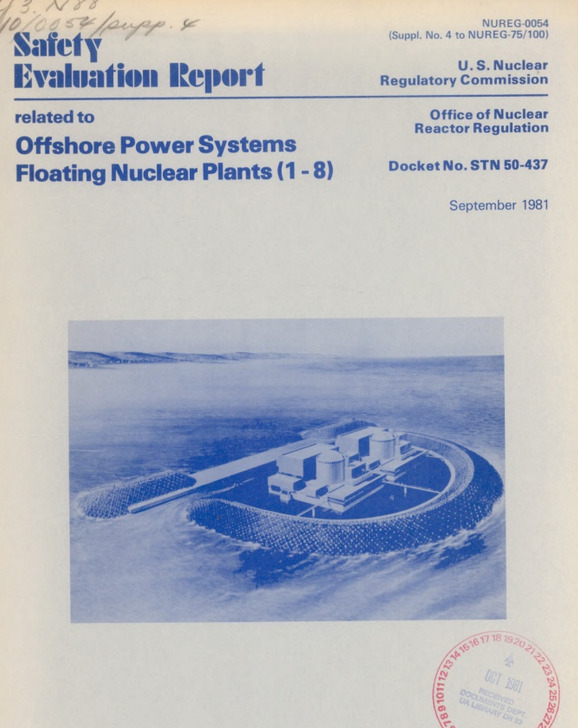
By 1981, OPS had invested $125 million into its manufacturing facility on Blount Island.9 The company was eager to get an official license to build, claiming that pre-licensed plants are significantly easier to sell to customers. In October 1981, the NRC’s Advisory Committee on Reactor Safeguards (ACRS) reported that:
The Floating Nuclear Plant units can be manufactured with reasonable assurance that they can be sited and operated without undue risk to the health and safety of the public.
The manufacturing license to construct the first 8 3411 MWt reactors was issued on December 17. 1982.
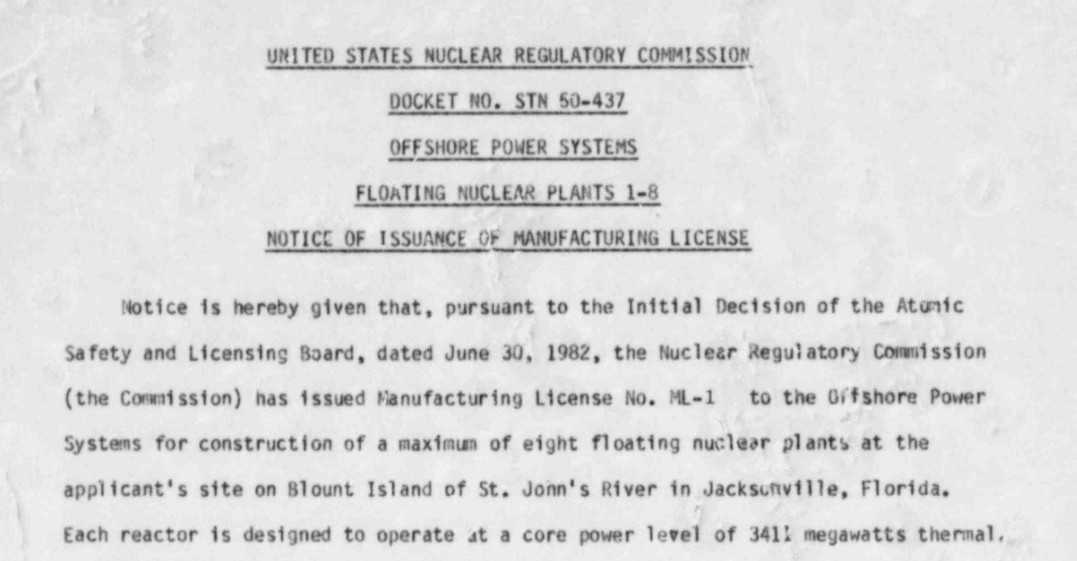
So what happened?
When the idea was born in 1969, everyone thought electricity demand was going to increase at 8%/year forever. After the 1973 oil shocks, the big customers in New Jersey (oil refineries) had far less demand than anticipated. By the time the OPS plants were ready to be produced, PSE&G could no longer justify the additional generation capacity. OPS held on for as long as it could but never was able to secure another customer. TMI had just happened and the industry was in a period of uncertainty. Eventually, they bit the bullet and shut down the production facility and the effort ended.
The general safety case (or, why it’s not a mobile Chernobyl)
The fundamental safety challenge in nuclear power is maintaining cooling of decay heat. Nuclear reactors don’t shut all the way down when the control rods go in; they drop to 7% of full power while the fission products start to slowly release their residual energy. After a day it’s at 1%. After 4 days it’s at 0.5%, and so on. Of course, 1% of 3 gigawatts is 30 million watts. Thus, plants must have reliable means of removing the heat after shutdown. Failure of this cooling caused the accidents at Three Mile Island (a valve was stuck open and the cooling water was lost) and at Fukushima (the tsunami took out the fuel supply for the backup diesel generators, which were in the basement instead of above grade where they should have been in a tsunami zone).
The much lauded advanced reactors of the world almost always feature passive decay heat removal systems. They use exotic coolants like sodium metal or molten salt which can naturally circulate with no external power, dumping their heat to the environment through passive heat exchangers.
At sea, you are floating in the world’s largest heat sink. In any and every scenario, there is sufficient cooling water to use, regardless of plant design.
The largest natural cause of potential decay heat loss on Earth is, of course, the earthquake. At sea, you are decoupled from the ground acceleration and will not experience violent shaking. Tsunamis are in the sea, of course, but in moderately deep water their wavelengths are enormous. They only become destructive when they crash into the shore.
Lastly, when you’re a few miles out at sea, very few people will be nearby. In the worst imaginable impossible case, radiation dose rates would be much diminished.
In return, you do have to deal with ship collisions, hurricanes, and storm swells. Critics also worried that if the core were to be severely damaged somehow and melt through all layers of containment, the energetics of hot core hitting the ocean could have caused a serious radiological event. With the core ladle and infinite heat sink, such an event is unlikely. Of course, the nuclear industry lost a lot of its credibility with statements like this after TMI.
Net, offshore nuclear plants produced in a shipyard offer rare combination of improved safety and improved cost.
Modern Echos
In 2010, the U.S.S. Carl Vinson aircraft carrier used it’s nuclear-powered oceanwater desalination capabilities (400,000 gallons/day capacity) to provide relief to the incapacitated water network (paywall) at Port-au-Prince, Haiti after a devastating earthquake.
Many teams are talking about and actually building shipyard constructed FNPPs today. Most of the modern concepts do not have the massive concrete breakwater. In 2016, MIT published a study of a new Offshore Floating Nuclear Plant Concept. in 2019, China announced that they would start building FNPPs to power islets and offshore drilling platforms in the South China Sea. In December 2019, the Russian Akademik Lomonosov FNPP began operating in the Arctic.
Some small advanced nuclear companies are planning to use shipyard construction and/or floating operation. ThorCon plans to use shipyard construction but then deliver their plants to land-based sites. OPS had a similar option for riverine sites. Seaborg plans to operate their reactors offshore.
In 2020, South Korea’s Kepco Engineering and Construction Company and Daewoo Shipbuilding and Marine Engineering signed a MOU to develop offshore nuclear plants. This team is particularly interesting because they combine one of the best and most mature reactor teams with one of the best shipbuilders.
With climate change looming, FNPPs may be one of the best ways to build vast amounts of very low-carbon nuclear plants in record-breaking time with unsurpassed quality and economics. Tens of millions of dollars have already been spent on a massive amount of environmental impact. The Coast Guard, EPA, NRC, and ACRS had reason to sign-off on the concept in the environmentalist era. The NRC even accepted modifications made after the TMI accident. professional environmentalists who worked on it came to like the concept.
I knew I liked the concept of floating nuclear power plants to fight climate change before, but I was worried about all the studies of environmental impacts that would need to be performed first. Now that I realize that well-funded studies have already concluded successfully, I’m even more emboldened to like and promote the idea of FNPPs for climate.
References
[1] Atomic Energy Programs, Regulatory Activities (1972)
[2] Ashworth, Atlantic Generating Station, Nuclear Technology, Vol. 22 (1974)
[3] McPhee, The Atlantic Generating Station, The New Yorker, May 12, 1975. — an incredibly well-written and well-researched long-form article about the whole endeavor of the Atlantic Generating Station and OPS. Highly worth finding in the archives and reading.
[4] Offshore Jersey A Plant Backed in Federal Study — Discussion of opposition, fear that beaches would be shunned
[7] Buongiorno, Offshore Floating Nuclear Plant Concept, Nuclear Technology, Vol 194 (2016)
[9] Boca Raton News, Sunday Nov 15, 1981
See Also
- Will Davis The Atlantic Generating Station (2013)
- Rod Adams, Offshore Power Systems, Big Plants for a Big Customer (1996)
- Reimann, In the 1980s, a power company almost built a floating nuclear power plant off New Jersey (2017)
- Shore effect model, Atlantic Generating Station — includes some great photos of wave model testing
- Impact of offshore nuclear generating stations on recreational behavior at adjacent coastal sites
- Nuclear Powerplant Standardization
- The American Plan to Build Nuclear Power Plants in the Ocean
- Selfridge Floating Nuclear Power Plants: A fleet on the horizon?
- Science Friday, Shipping Nuclear Power Out To Sea — A discussion inspired by this post
- Huge crane sold to China — A 1990 newspaper article about the OPS crane being sold to China
- Floating Nuclear Power Plants — a NRC historian version of this OPS story
- Museum picture of OPS model
- Making of Nuclear Plants Backed by Jersey Utility — New York Times article
- Before licensing floating nuclear powerplants many answers are needed — a US GAO report from 1978 before the license was issued
